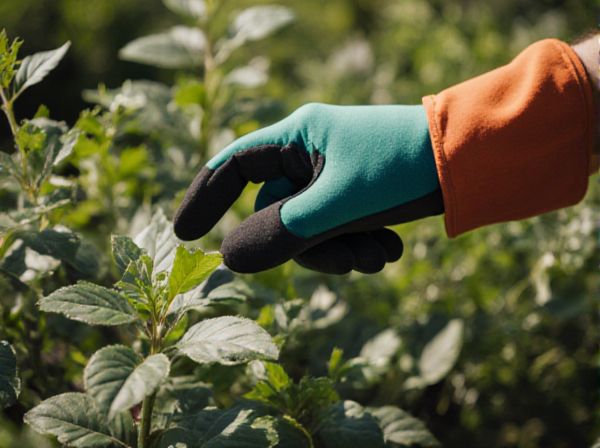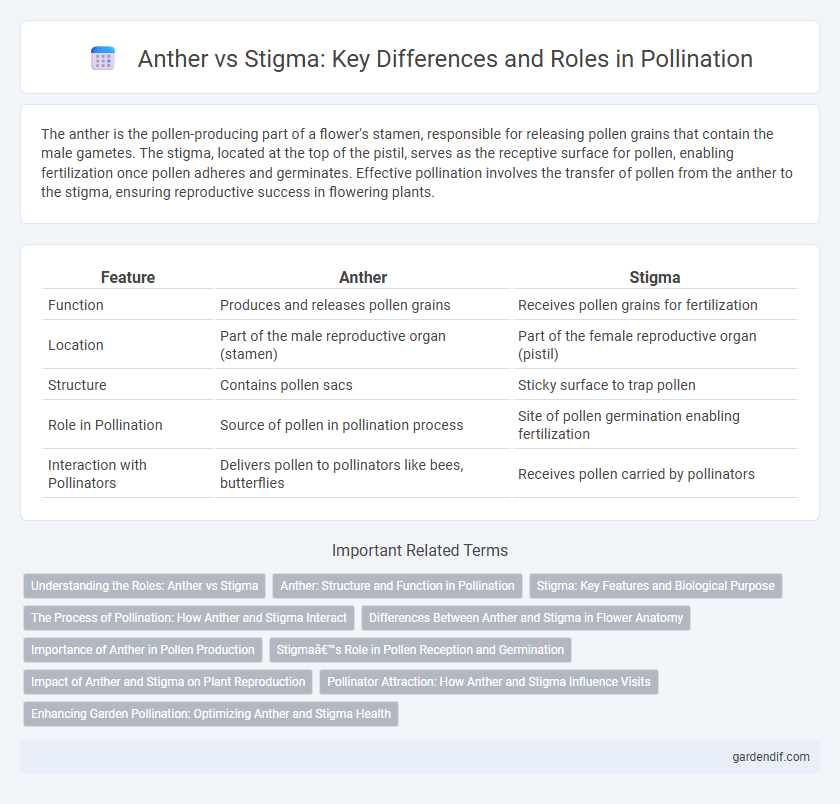
Anther vs Stigma Illustration
The anther is the pollen-producing part of a flower's stamen, responsible for releasing pollen grains that contain the male gametes. The stigma, located at the top of the pistil, serves as the receptive surface for pollen, enabling fertilization once pollen adheres and germinates. Effective pollination involves the transfer of pollen from the anther to the stigma, ensuring reproductive success in flowering plants.
Table of Comparison
| Feature | Anther | Stigma |
|---|---|---|
| Function | Produces and releases pollen grains | Receives pollen grains for fertilization |
| Location | Part of the male reproductive organ (stamen) | Part of the female reproductive organ (pistil) |
| Structure | Contains pollen sacs | Sticky surface to trap pollen |
| Role in Pollination | Source of pollen in pollination process | Site of pollen germination enabling fertilization |
| Interaction with Pollinators | Delivers pollen to pollinators like bees, butterflies | Receives pollen carried by pollinators |
Understanding the Roles: Anther vs Stigma
The anther, a key component of the stamen, produces and releases pollen grains essential for plant fertilization, serving as the male reproductive organ. The stigma, part of the pistil, functions as the receptive surface that captures pollen, facilitating pollen germination and subsequent fertilization of the ovules. Understanding the distinct roles of the anther and stigma highlights their critical connection in sexual reproduction and pollinator interactions.
Anther: Structure and Function in Pollination
The anther, a crucial part of the stamen in flowering plants, is responsible for producing and releasing pollen grains, which contain the male gametes necessary for fertilization. Its structure typically consists of two lobes, each with pollen sacs where microspores develop into pollen. During pollination, the anther's timing and positioning facilitate effective pollen transfer to pollinators or directly to the stigma, ensuring reproductive success.
Stigma: Key Features and Biological Purpose
The stigma is the receptive tip of a flower's pistil, specialized for capturing pollen grains with its sticky or feathery surface, facilitating effective pollination. Its position atop the style ensures that pollen is transferred directly to the ovary for fertilization, playing a crucial role in sexual reproduction in flowering plants. The stigma also aids in species-specific pollen recognition, promoting successful fertilization and genetic diversity.
The Process of Pollination: How Anther and Stigma Interact
The anther releases pollen grains that contain male gametes, which are transferred to the stigma during pollination. The stigma's surface is often sticky or feathery to effectively capture and hold the pollen for fertilization. This interaction initiates the process where pollen tubes grow from the pollen grains down the style to the ovary, facilitating fertilization and seed development.
Differences Between Anther and Stigma in Flower Anatomy
Anthers and stigmas are essential components of flower reproductive anatomy with distinct functions; the anther produces and releases pollen grains, serving as the male reproductive part, while the stigma acts as the receptive surface for pollen during fertilization, belonging to the female reproductive system. The anther is typically located at the tip of the stamen and contains pollen sacs, whereas the stigma is part of the carpel, positioned atop the style, designed to capture and hold pollen for germination. Structural differences include the anther's pollen-producing cells contrasted with the stigma's sticky or feathery surface adapted for effective pollen adhesion and reception.
Importance of Anther in Pollen Production
The anther is a crucial component of the stamen responsible for producing pollen grains, which contain the male gametes necessary for plant reproduction. Its efficient pollen production ensures successful fertilization by facilitating the transfer of viable pollen to the stigma of flowers. Without a well-functioning anther, the pollination process would be severely impaired, affecting seed formation and plant biodiversity.
Stigma’s Role in Pollen Reception and Germination
The stigma is the specialized receptive surface of the flower's pistil that captures pollen grains during pollination. Its sticky or feathery texture facilitates effective pollen adhesion, while biochemical signals stimulate pollen germination and guide the pollen tube growth toward the ovule for fertilization. This crucial role in pollen reception directly influences successful seed development and plant reproduction.
Impact of Anther and Stigma on Plant Reproduction
Anthers release pollen grains that contain male gametes essential for fertilizing ovules, directly influencing successful plant reproduction and genetic diversity. The stigma serves as the receptive surface for pollen, enabling pollen adhesion, germination, and pollen tube growth toward the ovary, which is critical for fertilization. Effective interaction between anther and stigma ensures efficient pollination, seed formation, and overall reproductive success in flowering plants.
Pollinator Attraction: How Anther and Stigma Influence Visits
The anther releases pollen coated with specific chemical cues and visual signals that attract pollinators by indicating a food source, while the stigma's surface texture and color can signal reproductive readiness and influence pollinator behavior. Anther positioning enhances pollen transfer efficiency by aligning with pollinator anatomy, increasing visit frequency and pollen deposition. Stigma traits, such as stickiness and nectar presence, further encourage pollinators to remain longer, optimizing pollen receipt and fertilization success.
Enhancing Garden Pollination: Optimizing Anther and Stigma Health
Optimizing garden pollination requires maintaining the health of both anthers and stigmas, as anthers produce pollen crucial for fertilization while stigmas receive pollen to enable seed development. Ensuring proper hydration and nutrient availability enhances anther pollen viability and stigma receptivity, directly boosting pollination efficiency. Gardeners should focus on environmental factors like humidity and soil quality to support these reproductive structures, fostering a thriving pollinator ecosystem.
Anther vs Stigma Infographic

 gardendif.com
gardendif.com